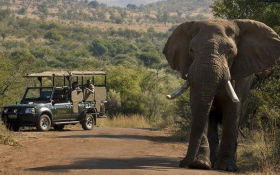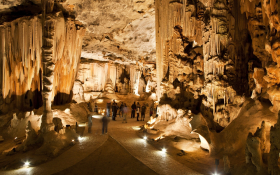
South Africa Sightseeing
- Garden Route
- Cape Town & Winelands
- Johannesburg & West
- Kruger National Park
- KwaZulu Natal
- View Courses of South Africa
< The Cango Caves

< The Tsitsikamma Coastal National Park
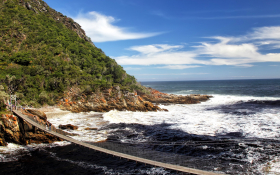
< Garden Route - Overview
< Plettenberg Bay
Situated close to Oudtshoorn, an hour from George, the Cango Caves is one of the world's great natural wonders The limestone beds of the Cango Group are, through movement in the Earth's crust, no longer in a horizontal plane. The layers of strata are also displaced laterally, forming dykes. Rainwater, combined with acidic carbon dioxide from decomposing plant material on the surface, flows through a fracture zone. Limestone, i.e., calcium carbonate plus water and carbon dioxide = Calcium Bicarbonate - which dissolves in water, flows out. This process of `cave making' takes millions of years. Trained guides are at hand to conduct visitors along the magic paths of the world's finest stalactite cave. Tours are not recommended for those who are claustrophobic in any way.
The Tsitsikamma Coastal National Park at the Eastern edge of the Garden Route, stretches 67 kilometers along some of the most spectacular coastline of Southern Africa. The main access to the park takes one to the mouth of the Storms River, where the dark peat stained river waters which have flowed through deep gorges finally meet the ultramarine blue ocean. The scenic drive from Knysna takes about 70 minutes (110km). One has the choice of taking the fast toll road over the giant Bloukrans and Groot River gorges or meander slowly through the passes on the old road. You can watch the bungee jumping from the Blaaukraans view site. Or if you are brave enough, try the worlds highest jump yourself!! The tourist camp at the Storms River mouth is the start of the popular Otter Trail and has a restaurant and shop. Walk along the coast and examine the interesting rock pools or just sit and watch the waves making great masses of white foam as they crash onto the rocky coast. The forest nature trail to the river mouth and across the suspension bridge is a must. Make an early start from Knysna and enjoy a day filled with the wonders of Nature.
The Garden Route and Little Karoo's natural assets will have you question ever wanting to leave this idyllic spot! The Garden Route and Little Karoo spans from Witsands whale birthing haven in the West to Plettenberg Bays beach, polo and party-going pleasures in the East. Then there’s the arid geological basin along the interior, wedged between the fynbos-rich Heidelberg in the west and Uniondales eastern sheep farming and rock art treasures. It’s all about an abundance of blue skies, white sand beaches, rolling oceans, mountain scenery, indigenous fynbos, ostrich antics and local hospitality. A place where you can travel along routes where you are often alone on the open road or make for the malls and beaches Golden vineyards, sun-drenched orchards, pin-drop-silent forests, sweeping lakes and birds eye view passes add to the mix. This is also the GOLF ROUTE as development has seen the construction of 5 of the best 12 courses in the country along this coast.
Plettenberg Bay is a very popular holiday resort about 32km (half hour drive) from Knysna. Take a very pleasant day trip to Plett stopping off to take a relaxing forest walk through the Garden of Eden The walk is also suitable for people in wheelchairs. A few kilometres further on is the turnoff to Harkerville and Kranshoek which has one of the most spectacular views of the rugged coastline. Plett, as it is affectionately called, has sparkling white beaches and some of the best swimming and surfing in the Garden Route There are two lagoons with lots of hermit crabs and inquisitive seagulls. The lovely long walks along the edge of the azure sea are often rewarded with whale and dolphin sightings. Plett has lots of places to eat and interesting shops,
< Winelands
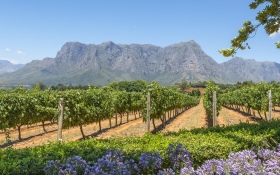
< Table Mountain
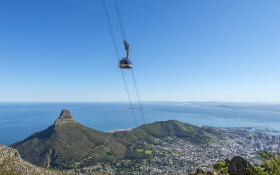
< Robben Island
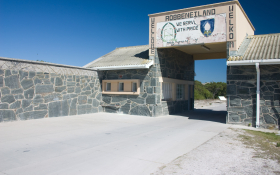
< The V&A Waterfront
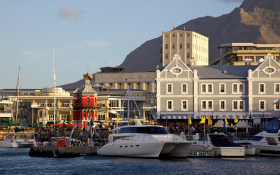
< Cape Town - Overview
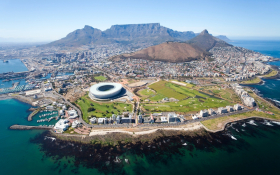
< Cape Point
< The Castle
For those not spending a few days in the Winelands, we suggest you spend a free day on a guided Winelands tour. With vineyards dating back 350 years and some of the finest cuisine to be found anywhere, the Cape Winelands provides for all palates. Cellar tours, cheese tasting, lunches or picnics can all be arranged.
A sandstone plateau rising up above the Cape Flats. The top is approximately 3km wide, and at its highest point, Maclear’s Beacon, rises to 1085m. Over the centuries it has become one of South Africa's most famous landmarks. The steep cliffs and rocky outcrops of the mountain play home to a number of plants and animals. The mountain is home to approximately 1470 species of plants; more than the entire British Isles! Complimenting this array of flora is a stunning range of fauna, some, like the Table Mountain Ghost Frog, being found in no other place in the world. The weather on the summit is very changeable and the cable car cannot be pre-booked.. It is best to check the weather section of the website or phone the information line on (021) 424 8181 to check if the cable car is open or closed. Always bring a warm jacket with you, as the temperature is often cooler on the summit than at the lower station. If you plan to walk to the highest point on the mountain, Maclear’s Beacon, be sure to wear a good pair of walking shoes.
For nearly 400 years, Robben Island, 12 kilometers from Cape Town, was a place of banishment, exile, isolation and imprisonment. It was here that rulers sent those they regarded as political troublemakers, social outcasts and the unwanted of society. During the apartheid years Robben Island became internationally known for its institutional brutality. The duty of those who ran the Island and its prison was to isolate opponents of apartheid and to crush their morale. Some freedom fighters spent more than a quarter of a century in prison for their beliefs. Those imprisoned on the Island succeeded on a psychological and political level in turning a prison 'hell-hole' into a symbol of freedom and personal liberation. Robben Island came to symbolize, not only for South Africa and the African continent, but also for the entire world, the triumph of the human spirit over enormous hardship and adversity. Robben Island is now a world heritage site and marine reserve, giving visitors magnificent views of city of Cape Town and Table Mountain. The three and a half hour tour includes a return trip across Table Bay, a visit to the Maximum Security Prison, interaction with an ex-political prisoner and a 45 minute bus tour with a guide providing commentary. We suggest that you pre-book a seat on the boat by using your hotel or driver concierge service.
Situated between Robben Island and Table Mountain in the heart of Cape Town's working harbour, the Victoria & Alfred Waterfront has become South Africa's most visited destination. Set against a backdrop of magnificent sea and mountain views, exciting shopping and entertainment venues are intermingled with imaginative office locations, world-class hotels and luxury apartments in the residential marina.
Cape Town is considered as the “Mother City” of South Africa. Since 1652 it has been ruled by the Dutch (twice) the French and the English. Add to that the Eastern and African cultures introduced by slaves and migrants and you have one of the most diverse local populations that you could wish to find. Whilst the people are friendly and interesting, the scenery is spectacular. With Table Mountain framing the city and white beaches surrounding it, Cape Town has long been a summer vacation playground for South Africans and International folk looking for something unique. Culturally Cape Town is at its most active during the months from June to September when the silly season is over and people get down to doing what they do best, relaxing and enjoying the Cape Town lifestyle. The Cape Winelands, as the name would suggest, is the largest wine producing region in the South Africa. With a selection of over 200 cellars to choose from, you are guaranteed to taste some of the finest wines in the world. Experience the rich historical and cultural heritage while visiting quaint villages and vibrant townships, museums and galleries, theatres and festivals. The Winelands is a wonderfully romantic destination and is second to none when it comes to gastronomic options. PerryGolf recommends at least 4 nights in Cape Town and the Winelands Regions as each are easily accessed from the other and both provide very unique experiences.
At the tip of the Cape Peninsula – 60 km south-west of Cape Town – the rugged rocks and sheer cliffs cut deep into the ocean to split False Bay from the colder waters of the western seaboard. This outcrop of the Table Mountain National Park is called Cape Point. Bartholomeu Dias, the Portuguese seafarer, was the first to sail around the Cape. This was in 1488. On his return voyage – which must have been particularly stormy – Dias stopped at the south-western tip of Africa, and named it Cabo Tormentoso, or Cape of Storms. Apart from its spectacular beauty and views, here a few good reasons to visit Cape Point: · The most southwesterly point of Africa; Breathe the freshest air in the world – straight from the Antarctic; It’s where the cold Beguela current on the West coast and the warm Agulhas current on the East coast merge; Situated in the 22 100 hectare Table Mountain National Park; One of the highest sea cliffs in the world – 249 m above sea level; The circumnavigation of the Cape of Good Hope led to the establishment of a sea route to the East and subsequent trade; 26 recorded shipwrecks; Bird watcher's paradise – at least 250 species.
Built between 1666 - 1679, the Castle is the oldest structure in South Africa, which today serves as headquarters for the Western Province Army Command. The castle houses the William Fehr Collection of Africana, which provides a glimpse of life at the Cape during the 17th and 18th centuries and the Castle History Museum. The "castle" is actually a defensive fort, construction of which began barely 2 days after the arrival of the first Dutch settlers in April 1652. Although today the Castle is far away from the sea, it was originally built on the beach, Strand Street, which passes the structure is translated as "Beach Street". The area where the Cape Town station now stands was originally under the ocean and has been built on land reclaimed over the years so that today the ocean is a couple of kilometers distant. The castle is open daily from 09h00 to 16h00, Monday to Saturday (open Sundays during December) except Christmas day and New Years day. Daily tours are conducted at 11h00, 12h00 and 14h00. The changing of the guard is held Monday to Friday at 12h00.
< Bourkes Luck
< Gods Window
< The Town of Pilgrims Rest
< Pilanesburg Safari from Sun City (Costed)
At the confluence of the Blyde and Treur Rivers in Mpumalanga is an amazing geological formation known as the Bourkes Luck Potholes. The scouring of water-borne pebbles over countless centuries has carved out a collection of surreal rock shapes which really look spectacular. They are named after a miner, Tom Bourke, who struck it lucky at a mine he opened nearby
At God's Window on the Escarpment, majestic cliffs plunge over 900 meters to the Lowveld and the game reserves which have made the area one of Africa's prime wildlife destinations. From this Escarpment - a 250km long rampart of sheer cliffs - it indeed seems as if one can see forever! With its magnificent views, rock formations, canyons and waterfalls, the Lowveld Escarpment is truly an area of breathtaking scenic grandeur. Known as Paradise Country, this lush region has several spectacular natural features, The canyon forms part of a nature reserve, inhabited by various species of antelope, wild cat and birds, including the eagle, ibis, parrot and loerie. Viewing sites are provided along the length of the canyon and there are numerous walks, hiking, horse and mountain bike trails.
A living museum, the entire town has been declared a national Monument - taking the visitors to the day of old Transvaal Gold Rush. Pilgrim's Rest was declared a gold field in 1873, soon after digger Alec "Wheelbarrow" Patterson had found gold deposits in Pilgrim's Creek. The Valley proved to be rich in gold and by the end of the year, there where about 1500 diggers working in the area. As a result, Pilgrim's Rest became a social center of the diggings. Mining was active until 1971 when Beta Mine was closed down. Transvaal Gold Mining Estates opened again in 1999 and there is active gold mining in the hills around Pilgrim's Rest. Pilgrims Rest is now the home of “World Gold Panning Championships”
< The Kruger National Park
The world-renowned Kruger National Park offers a wildlife experience that ranks with the best in Africa. Established in 1898 to protect the wildlife of the South African Lowveld, this national park of nearly 2 million hectares, Kruger National Park is unrivalled in the diversity of its life forms and a world leader in advanced environmental management techniques and policies. Truly the flagship of the South African national parks, Kruger is home to an impressive number of species: 336 trees, 49 fish, 34 amphibians, 114 reptiles, 507 birds and 147 mammals. Man's interaction with the Lowveld environment over many centuries - from bushman rock paintings to majestic archaeological sites like Masorini and Thulamela - is very evident in the Kruger National Park. These treasures represent the cultures, persons and events that played a role in the history of the Kruger National Park and are conserved along with the park's natural assets.
< Battlefields
< Killie Campbell Museum
< KwaZulu-Natal - Overview
< The Drakensberg
< Valley of 1000 hills
Zulu wars, Shaka, Isandlwana, Rorkes Drift, Colenso, Spioenkop, Ladysmith, Dundee, Churchill, Blood River, Cetshwayo, Boers ... are some of the terms which are associated with this internationally renowned area of South Africa. For decades various factions of Native African, Imperial British Forces and “Voortrekkers” from the Cape fought over this piece of land, each time adding to the rich history of all nations. This is a story tellers paradise and a journey with an experienced guide will make it an unforgettable experience. This is a full day tour, or better still if enjoyed with an overnight journey, staying at Fugitives Drift Lodge.
The William Campbell picture collection contains one of South Africa's finest collections of work by black South African artists such as Jabulani Ntuli, Gerard Benghu and Dsmt Mnguni. The collection also includes 250 paintings by Barbara Tyrell, depicting Zulu social life and customs. The museum is still furnished much as it was when the Campbell family was still there. Viewing by appointment only.
KwaZulu-Natal or the Zulu Kingdom includes Durban, the Drakensberg Mountains, Elephant Coast, Pietermaritzburg and Midlands, Zululand, South Coast, North Coast (Dolphin Coast) and the Battlefields regions. The native Zulu culture is strongly intertwined with Colonial English and Migrant Indian, offering guests a unique cultural insight into a truly rainbow Nation. KwaZulu Natal is a region that shaped world history. It is where the modern British Army was defeated by Iron Age Zulu warriors, where Winston Churchill cut his teeth in war time politics, where France lost it’s last Prince and where Mahatma Gandhi founded his doctrine of peaceful resistance.
Recognized by the ancient mystics of our land as breathing new life into the human spirit, the inescapable allure of this 200- kilometer- long wonderland owes much to its intense relationship with people...the million-plus years of Stone Age occupation in particular. This culminated in the tragic disappearance, during the late 19th century, of the San hunter-gatherers colloquially referred to as Bushmen. Migrating chiefdoms from the Great Lakes of Central Africa had in the 13th century been humbled by the sheer magnitude of this uKhahlamba - Barrier of Spears - destined to become the western extreme of their Zulu Kingdom. The ox-wagons of Boer settlers finally negotiated its precipitous passes in 1837 on the Great Trek from British dominion in the Cape Colony to a 'Promised Land'. The name Drakensberg was coined forty years later when a Boer father and son reported seeing a dragon - a giant lizard with wings and a tail - flying high above the cloud-shrouded mountain peaks. The inscription in late 2000 of uKhahlamba-Drakensberg Park as a World Heritage Site brought long-overdue recognition of its universal value to mankind. Meeting the criteria for both Natural and Cultural listings, the site can now officially boast 'superlative natural phenomena and beauty, unique richness of biological diversity, the conservation of all-important endemic and threatened species plus masterpieces of human creative genius in the form of 35 000 'San rock art images'. Many people have known this for a long time! From the massive basalt cliffs of its northern reaches to the soaring sandstone buttresses in the south, the Berg - as it's popularly known - offers a myriad delights to anyone of any age who needs to 'get away from it all'. Peace and quiet is the catchphrase amid this unsurpassed grandeur where the world's second- highest waterfall (Tugela Falls) tumbles down a series of breathtaking cascades. The Drakensberg is best enjoyed as a full day guided tour or as part of an overnight program in conjunction with the battlefields.
The seemingly eternal tranquility of these rolling hills belies the blood-soaked drama that unfolded almost two centuries ago with the arrival of King Shaka's unstoppable regiments. Immediately after his coronation in 1816, the 'Black Napoleon' set about subjugating all the tribes that today constitute our Kingdom of the Zulu, and the Thousand Hills' Debe clans folk were given no exemption - those who did not flee either capitulated to the monarch of Africa's newest empire or stood, fought and were overwhelmed by Shaka's military genius. Today, opportunities abound to discover at first hand the intricacies of ethnic customs and beliefs that inform day- to-day life in the many welcoming, beehive-hutted villages that adorn these hillsides. A guided tour of this area is a must for guests looking for a better understanding of Zulu culture.

